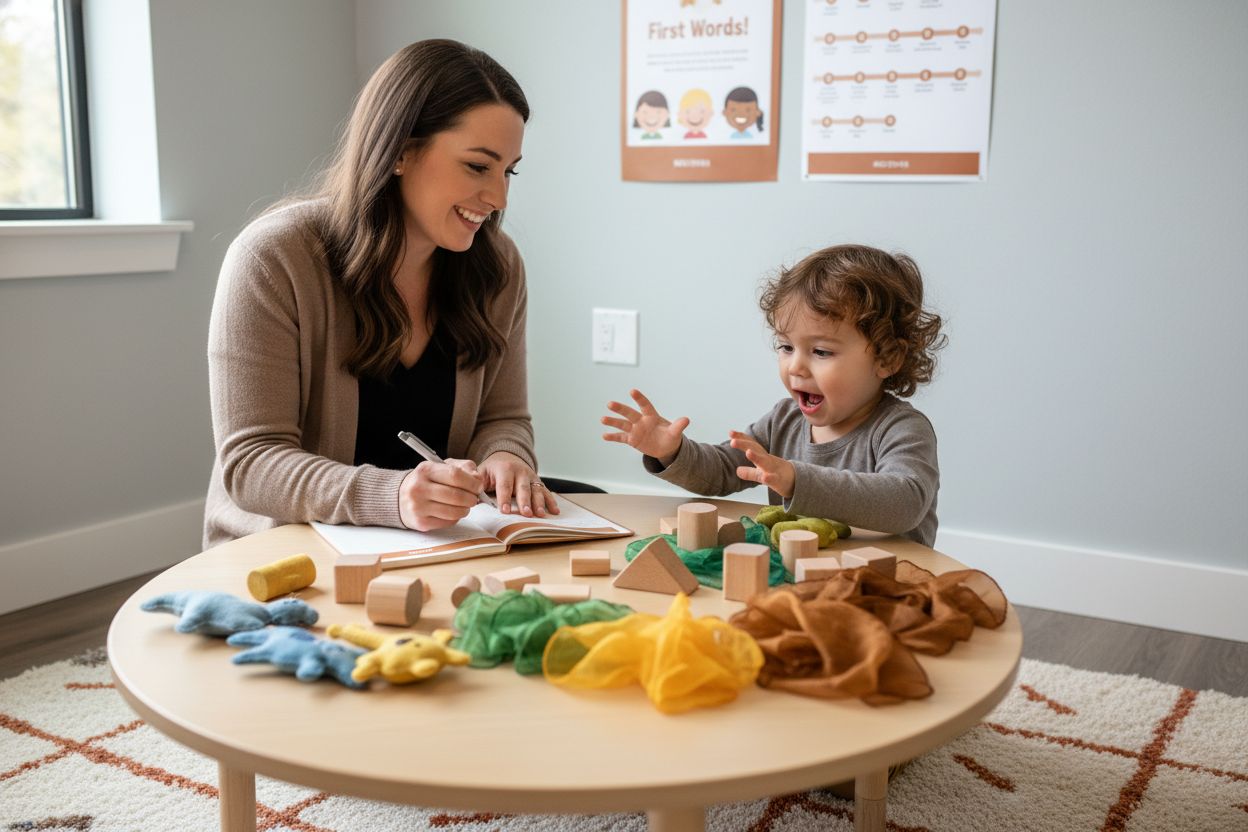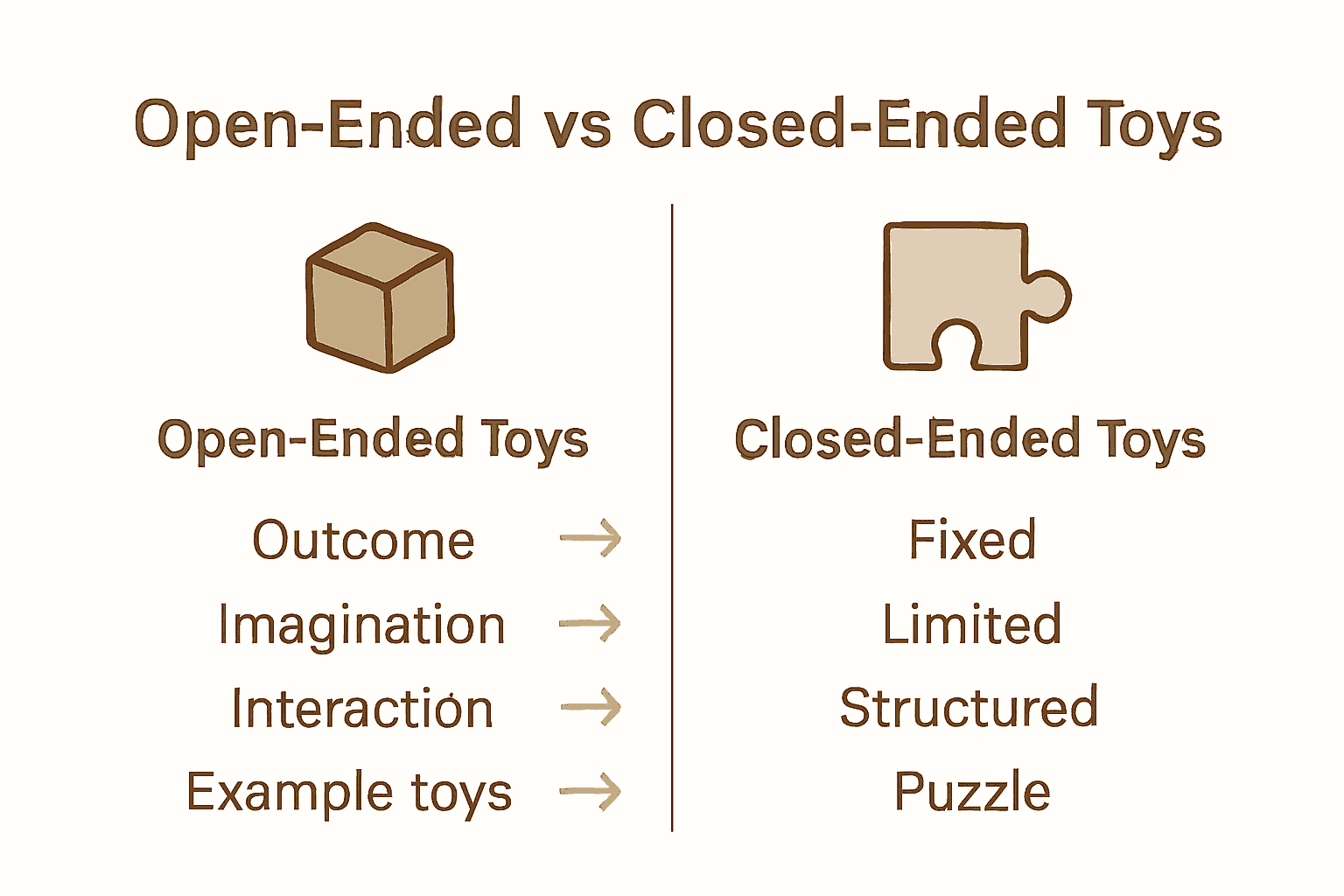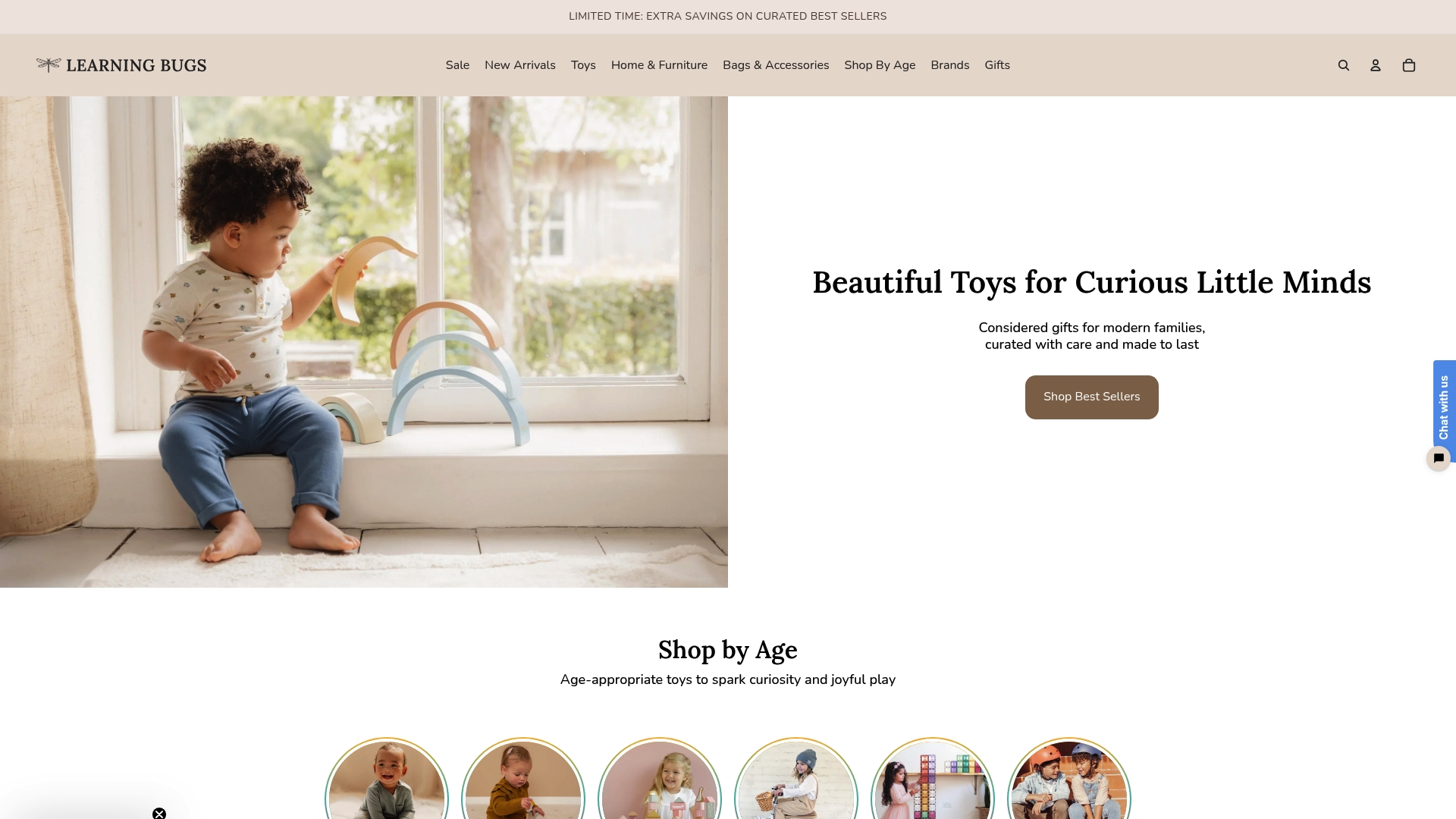Did you know that open-ended play is linked to higher creativity and language development in children? Most toys today tell kids exactly how to play, which can limit imagination. Open-ended toys turn a simple block or scarf into anything a child dreams up, from castles to rockets to story adventures. Choosing these flexible playthings can encourage problem-solving skills, build confidence, and inspire new ways for children to express themselves with every play session.
Key Takeaways
| Point | Details |
|---|---|
| Open-Ended Toys Foster Creativity | These toys encourage imaginative play and allow children to direct their own explorations without fixed outcomes. |
| Developmental Advantages | They support cognitive, emotional, and social development by enhancing problem-solving skills, emotional regulation, and collaboration. |
| Selecting Quality Toys | Focus on toys that promote versatility, simplicity, and developmental appropriateness to maximize engagement and growth. |
| Comparison with Closed-Ended Toys | Open-ended toys differ by offering limitless play potential, whereas closed-ended toys have specific outcomes and can limit creative thinking. |
Table of Contents
- Defining Open-Ended Toys And Core Concepts
- Key Benefits For Child Development
- Types Of Open-Ended Toys Explained
- How To Identify Quality Open-Ended Toys
- Comparing Open-Ended And Close-Ended Toys
Defining Open-Ended Toys and Core Concepts
Imagine a toy that transforms with your child’s creativity—no instructions, no fixed outcomes, just pure imagination. That’s the magic of open-ended toys. According to research from understanding why educational toys matter, these versatile playthings invite children to explore, experiment, and create without limitations.
At their core, open-ended toys are playthings without predetermined usage or specific instructions. They change with each interaction, allowing children to reinvent play experiences repeatedly.
Classic examples include:
- Wooden building blocks
- Play silks
- Loose natural materials like sand and stones
- Linking cubes
- Felt play sets
The beauty of these toys lies in their incredible flexibility. A wooden block isn’t just a block—it can become a castle tower, a car, a bridge, or a mathematical counting tool. Unlike prescriptive toys with fixed play patterns, open-ended toys grow alongside a child’s developing imagination and cognitive skills.
Beyond entertainment, these toys are powerful developmental tools. They encourage problem-solving, spatial awareness, creative thinking, and emotional expression. By removing structured limitations, open-ended toys invite children to take the lead in their play, fostering confidence and independent thinking in the most delightful, playful manner possible.
Key Benefits for Child Development
Open-ended toys are not just playthings; they are powerful developmental tools that nurture children’s cognitive, emotional, and social growth. Read more about creative toys and their significance, these versatile play objects offer remarkable benefits that extend far beyond simple entertainment.
According to UK early years guidance, open-ended play supports multiple critical developmental domains:
- Creativity Enhancement: Encourages imaginative thinking
- Problem-Solving Skills: Develops strategic cognitive approaches
- Emotional Regulation: Helps children process and understand feelings
- Social Collaboration: Promotes cooperative play and communication
- Independence: Builds confidence through self-directed exploration
Linguistic development represents another profound advantage. Research indicates that open-ended toys significantly support language acquisition. Through symbolic play and narrative construction, children develop complex vocabulary, pragmatic language skills, and metalinguistic awareness. A wooden block becomes more than an object—it transforms into a storytelling medium where children articulate elaborate scenarios, practicing communication and comprehension.
Moreover, these toys offer a unique stress-reduction mechanism. By providing an unstructured play environment, open-ended toys help reduce childhood anxiety, allowing children to explore, experiment, and express themselves freely. They create safe psychological spaces where learning happens organically, turning play into a natural, joyful learning experience that supports holistic child development.

Types of Open-Ended Toys Explained
Open-ended toys come in a wonderfully diverse range of materials and designs, each offering unique opportunities for creative exploration. Learn more about educational toy collections, these versatile playthings transform ordinary objects into extraordinary learning experiences.
According to research, several key categories of open-ended toys stand out for their exceptional play potential:
Natural and Sensory Materials
- Sand and Water: Malleable substances that change shape and invite endless experimentation
- Loose Natural Parts: Stones, sticks, shells that can become anything from construction materials to storytelling props
- Wooden Elements: Blocks, discs, and shapes that encourage spatial reasoning
Constructed Play Materials
- Linking Cubes: Connectable pieces that support mathematical thinking and structural design
- Rainbow Pebbles: Colourful objects that can be sorted, stacked, and reimagined
- Play Silks: Lightweight fabrics transforming into costumes, landscapes, or imaginative barriers
Felt toys and modular building sets represent another fascinating category of open-ended play. These materials invite children to deconstruct and reconstruct their world, turning simple objects into complex narratives. A single piece of fabric might become a superhero’s cape, a river in a landscape, or a tent for imaginary adventures.
The magic of these toys lies not in their individual characteristics, but in their potential to spark imagination. By providing tools without prescriptive instructions, open-ended toys become portals to endless creativity, allowing children to explore, experiment, and express themselves in uniquely personal ways.
How to Identify Quality Open-Ended Toys
Selecting the right open-ended toys requires more than just picking colourful playthings—it’s about choosing tools that genuinely support your child’s developmental journey. Explore our guide to fine motor skills toys to understand how the right toys can enhance critical developmental capabilities.
According to research, quality open-ended toys share several key characteristics:
Material and Design Considerations
- Versatility: Adapts to multiple play scenarios
- Simplicity: Minimal design that sparks imagination
- Developmental Appropriateness: Matches child’s current cognitive stage
- Cultural Responsiveness: Inclusive design that reflects diverse experiences
Key Selection Criteria
- Prioritize toys that encourage:
- Creative problem-solving
- Social cooperation
- Imaginative exploration
Research emphasizes avoiding electronic or single-function toys that limit creativity. Instead, opt for materials like wooden blocks, art supplies, and loose parts that invite open-ended interaction. These toys become powerful learning instruments when they allow children to direct their own play, transforming simple objects into complex narratives and learning experiences.
Ultimately, the best open-ended toys are those that grow with your child. They should challenge and engage without constraining imagination, providing a blank canvas where creativity can flourish freely. By selecting toys that prioritize exploration over instruction, you’re not just buying a plaything—you’re investing in your child’s cognitive and emotional development.
Comparing Open-Ended and Close-Ended Toys
Toys are not created equal—and understanding the difference between open-ended and closed-ended toys can transform how we support children’s development. Explore our insights into Montessori toy principles to deepen your understanding of purposeful play design.
Key Differences
Open-Ended Toys:
- No predetermined outcomes
- Encourage imagination and creativity
- Support independent play
- Highly adaptable across multiple scenarios
- Promote complex problem-solving
Closed-Ended Toys:
- Have specific goals or rules
- Limited reuse potential
- Often follow a single play pattern
- Provide structured learning experiences
- Typically have a clear ‘correct’ way of playing
Research highlights a critical distinction in developmental impact. Closed-ended toys, like puzzle sets with predetermined solutions, offer structured learning but can limit creative thinking. In contrast, open-ended toys transform ordinary objects into extraordinary learning experiences, allowing children to create their own narratives and solutions.
Particularly noteworthy is the research comparing open-ended toys with electronic gadgets. While electronic toys often reduce caregiver-child interaction and limit language exposure, open-ended toys actively encourage communication, cooperative play, and rich imaginative scenarios. They become a canvas for exploration, where a simple wooden block can become a car, a building, a mathematical tool, or a storytelling prop—limited only by the child’s imagination.

Here’s a comparison of open-ended and closed-ended toys:
| Feature | Open-Ended Toys | Closed-Ended Toys |
|---|---|---|
| Play Outcome | No fixed result | Specific goal or solution |
| Imagination Encouraged | Yes | Limited |
| Reuse Potential | High Endlessly adaptable |
Low Single or few uses |
| Social Interaction | Promotes collaboration and communication | Often solitary or competitive |
| Learning Approach | Self-directed, creative problem-solving | Structured, task-based learning |
| Example | Wooden blocks Play silks |
Puzzles Electronic gadgets |
Make Every Playtime Count With Imagination-Boosting Toys
You have discovered how open-ended toys unlock a world of creativity and independent learning for children. Perhaps you are searching for ways to move beyond restrictive, single-use gadgets and find resources that truly encourage confidence, problem-solving and imagination. We understand that modern families want child development tools that are more than just entertaining – you want toys that are meaningful, versatile and enduring. The struggle to find toys that grow with your child rather than limit their play is real for so many parents.

Now is the perfect moment to transform ideas from the Complete Guide to Open-Ended Toys for Children into joyful reality. At Learning Bugs, you will find a thoughtfully curated selection inspired by the research-backed benefits discussed in this guide. Explore toys that spark emotional growth, creative storytelling and social collaboration – always with the support of detailed product guidance and guaranteed quality.
Ready to bring true open-ended play into your home? Visit Learning Bugs for imaginative toys trusted by UK families, all just a click away. Let your child’s developmental journey flourish today while these inspiring choices are in stock.
Frequently Asked Questions
What are open-ended toys?
Open-ended toys are playthings without predetermined usage or specific instructions, allowing children to explore, experiment, and create in limitless ways.
What are the key benefits of open-ended toys for child development?
Open-ended toys enhance creativity, problem-solving skills, emotional regulation, social collaboration, and independence, fostering comprehensive cognitive and emotional growth.
How do open-ended toys differ from closed-ended toys?
Open-ended toys encourage imagination and have no fixed outcomes, while closed-ended toys offer specific goals and often follow a single play pattern, which may limit creative thinking.
What characteristics should I look for in quality open-ended toys?
Quality open-ended toys should be versatile, simple in design, developmentally appropriate, and culturally responsive, ensuring they stimulate creative problem-solving and imaginative exploration.

0 comments